Effect of One- and Two-Stage Shear Cutting on the Fatigue Strength of Truck Frame Parts
Abstract
1. Introduction
2. Materials and Methods
2.1. Material
2.2. Shear Cutting Tool and Stamping Press
2.3. Fatigue Testing
2.4. Measurement Equipment
2.5. Experimental Procedure
3. Results and Discussion
3.1. Cut Surface Characteristics
3.2. Fatigue Strength
3.3. Roughness
3.4. Micrographs and Microhardness
4. Conclusions
- The die clearance should be chosen as or smaller for one-stage shear cutting to avoid delaminations. Otherwise, the influence of the die clearance on the cut surface characteristics was small in contrast to many other investigations where punches without a roof-top shape were used.
- The cutting offset should be big enough so that cracks from the first cutting operation were cut off completely.
- When the cutting offset was chosen too small, the burr height was heavily increased.
- When cutting offset and die clearance were chosen too big, delaminations could be observed.
- When cutting offset and die clearance were chosen too small, this may have resulted in an undefined transition from clean cut to fracture zone.
- Two-stage shear cutting resulted in a much higher amount of clean cut for all investigated configurations with a cutting offset .
- Shear cutting changed the slope of the limited lifetime fatigue strength line due to an additional notch, the very rough fracture zone.
- Both one- and two-stage shear cutting significantly reduced the number of cycles to failure compared to polished edges.
- A much higher fatigue strength could be achieved by two-stage shear cutting compared to one-stage shear cutting.
Author Contributions
Funding
Conflicts of Interest
References
- VDA. The Automotive Industry in Facts and Figures, Annual Report 2018; Association of the German Automotive Industry (VDA): Berlin, Germany, 2018. [Google Scholar]
- Heid, B.; Diedrich, D.; Kässer, M.; Küchler, S.; Kley, F. Route 2030—The Fast Track to the Future of the Commercial Vehicle Industry; McKinsey Center for Future Mobility: New York, NY, USA, 2018. [Google Scholar]
- Maronne, E.; Galtier, A.; Robert, J.; Ishikawa, T. Cutting process influence on fatigue sheet properties. WIT Trans. Eng. Sci. 2003, 40, 13–22. [Google Scholar]
- Gürün, H.; Göktaş, M.; Guldas, A. Experimental Examination of Effects of Punch Angle and Clearance on Shearing Force and Estimation of Shearing Force Using Fuzzy Logic. Trans. Famena 2016, 40, 19–28. [Google Scholar] [CrossRef]
- Senn, S.; Liewald, M. Experimental investigation of piercing of high-strength steels within a critical range of slant angle. J. Phys. Conf. Ser. 2017, 896, 012099. [Google Scholar] [CrossRef]
- Schenek, A.; Liewald, M.; Senn, S. Identification of process limits for punching with a slant angle. IOP Conf. Ser. Mater. Sci. Eng. 2019, 651, 012066. [Google Scholar] [CrossRef]
- Karjalainen, J.A.; Mäntyjärvi, K.; Juuso, M. Punching Force Reduction with Wave-Formed Tools. In Key Engineering Materials; Sheet Metal 2007; Trans Tech Publications Ltd.: Baech, Switzerland, 2007; Volume 344, pp. 209–216. [Google Scholar] [CrossRef]
- Singh, U.; Streppel, A.; Kals, H. Design study of the geometry of a punching/blanking tool. J. Mater. Process. Technol. 1992, 33, 331–345. [Google Scholar] [CrossRef][Green Version]
- Matsuno, T.; Sato, K.; Okamoto, R.; Mizumura, M.; Suehiro, M. Synergy effect of shear angle and anisotropic material ductility on hole-expansion ratio of high-strength steels. J. Mater. Process. Technol. 2016, 230, 167–176. [Google Scholar] [CrossRef]
- Matsuno, T.; Kuriyama, Y.; Murakami, H.; Yonezawa, S.; Kanamaru, H. Effects of Punch Shape and Clearance on Hole Expansion Ratio and Fatigue Properties in Punching of High Strength Steel Sheets. Steel Res. Int. 2010, 81, 853–856. [Google Scholar]
- Engin, K.; Eyercioglu, O. The Effect of Thickness to Die Diameter Ratio on Sheet Metal Blanking Process. Stroj. Vestn. J. Mech. Eng. 2017, 63, 501–509. [Google Scholar] [CrossRef]
- Lara, A.; Picas, I.; Casellas, D. Chapter Effect of the cutting process on the fatigue behavior of press hardened and high strength dual phase steels. J. Mater. Process. Technol. 2013, 213, 1908–1919. [Google Scholar] [CrossRef]
- Meurling, F.; Melander, A.; Linder, J.; Larsson, M. The influence of mechanical and laser cutting on the fatigue strengths of carbon and stainless sheet steels. Scand. J. Metall. 2001, 30, 309–319. [Google Scholar] [CrossRef]
- Thomas, D.J.; Whittaker, M.T.; Bright, G.W.; Gao, Y. The influence of mechanical and CO2 laser cut-edge characteristics on the fatigue life performance of high strength automotive steels. J. Mater. Process. Technol. 2011, 211, 263–274. [Google Scholar] [CrossRef]
- Paetzold, I.; Dittmann, F.; Feistle, M.; Golle, R.; Haefele, P.; Hoffmann, H.; Volk, W. Chapter Influence of shear cutting parameters on the fatigue behavior of a dual-phase steel. J. Phys. Conf. Ser. 2017, 896, 012107. [Google Scholar] [CrossRef]
- Stahl, J.; Müller, D.; Paetzold, I.; Golle, R.; Tobie, T.; Volk, W.; Stahl, K. The Influence of Residual Stresses Induced by Near-Net-Shape Blanking Processes on the Fatigue Behavior under Bending Loads. IOP Conf. Ser. Mater. Sci. Eng. 2019, 651, 012086. [Google Scholar] [CrossRef]
- Iwaya, J.; Okano, Y.; Ueno, K. Stretch Flangeability Improvement in Sheared Edge Steel Sheets with Double Punching. Nikai uchinuki ni yoru usukoban no nobi flange sei kojo 1997, 47, 33–37. [Google Scholar]
- Gläsner, T.; Sunderkötter, C.; Plath, A.; Volk, W.; Hoffmann, H.; Golle, R. Methods to Decrease Cut Edge Sensitivity of High Strength Steels. Key Eng. Mater. 2014, 611–612, 1294–1307. [Google Scholar] [CrossRef]
- Gläsner, T.; Sunderkötter, C.; Hoffmann, H.; Volk, W.; Golle, R. Development of a 2-stage shear cutting-process to reduce cut-edge-sensitivity of steels. J. Phys. Conf. Ser. 2017, 896, 012104. [Google Scholar] [CrossRef]
- DIN EN 10149-2. Hot Rolled Flat Products Made of High Yield Strength Steels for Cold Forming; Beuth Verlag GmbH: Berlin, Germany, 1995. [Google Scholar]
- DIN 50125. Testing of Metallic Materials—Tensile Test Pieces; Beuth Verlag GmbH: Berlin, Germany, 2016. [Google Scholar]
- DIN 6507. Metallic Materials-Vickers Hardness Test—Part 1: Test Method; Beuth Verlag GmbH: Berlin, Germany, 2018. [Google Scholar]
- DIN 5118. Tools for Pressing-Punches with Trombone Neck; Beuth Verlag GmbH: Berlin, Germany, 2017. [Google Scholar]
- VDI 2906-2. Quality of Cut Faces of (Sheet) Metal Parts after Cutting, Blanking, Trimming or Piercing-Shearing, Form of Sheared Edge and Characteristic Values; Beuth Verlag GmbH: Berlin, Germany, 1994. [Google Scholar]
- DIN EN ISO 4287. Geometrical Product Specifications (GPS)-Surface Texture: Profile Method-Terms, Definitions and Surface Texture Parameters; Beuth Verlag GmbH: Berlin, Germany, 2010. [Google Scholar]
- Pilkey, W.D.; Pilkey, D.F.; Bi, Z. Holes. In Peterson’s Stress Concentration Factors; John Wiley & Sons, Ltd.: Hoboken, NJ, USA, 2008; Chapter 4; pp. 176–400. [Google Scholar] [CrossRef]
- Einbock, S. Statistics of Metal Fatigue in Engineering: Planning and Analysis of Metal Fatigue Tests; Books on Demand: Norderstedt, Germany, 2018. [Google Scholar]
- Li, C.; Dai, W.; Duan, F.; Zhang, Y.; He, D. Fatigue Life Estimation of Medium-Carbon Steel with Different Surface Roughness. Appl. Sci. 2017, 7, 338. [Google Scholar] [CrossRef]
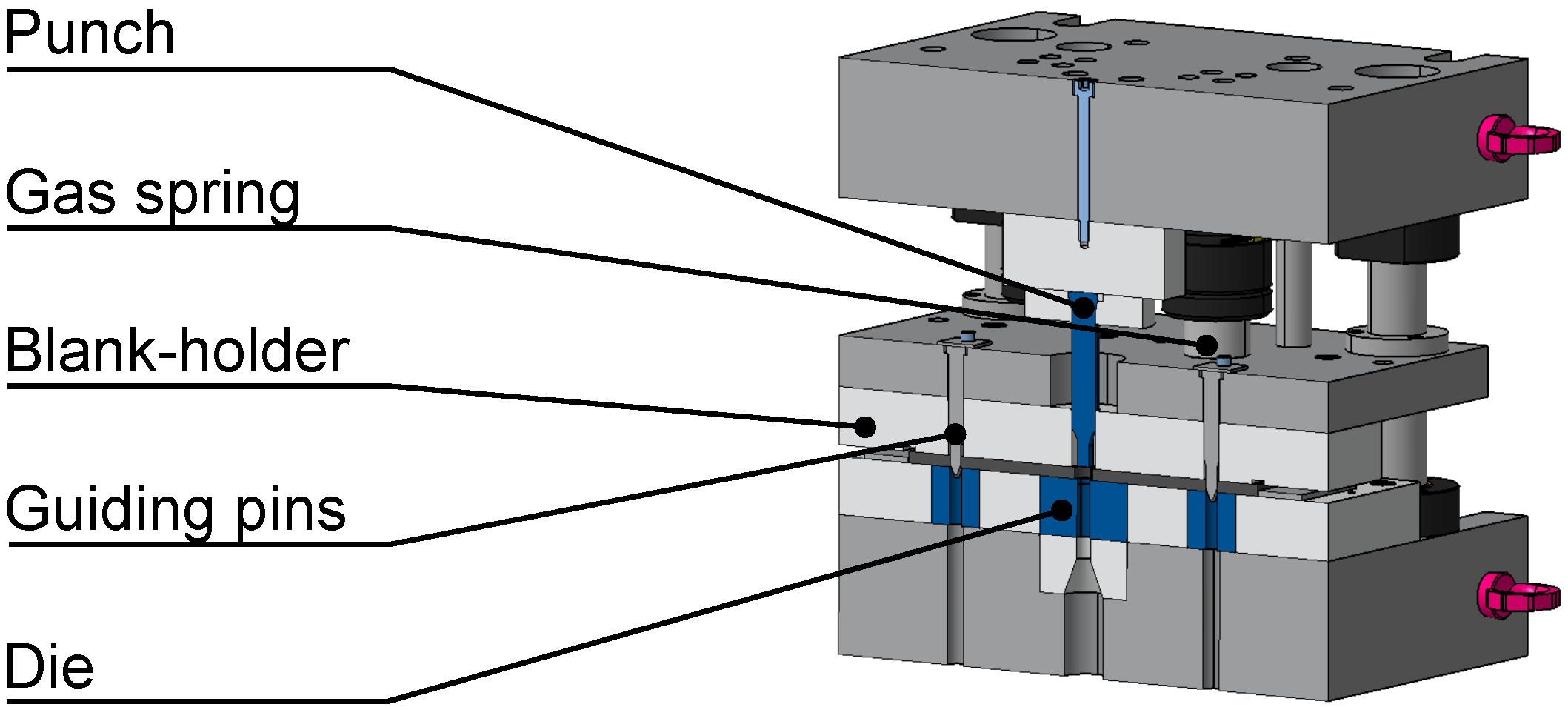

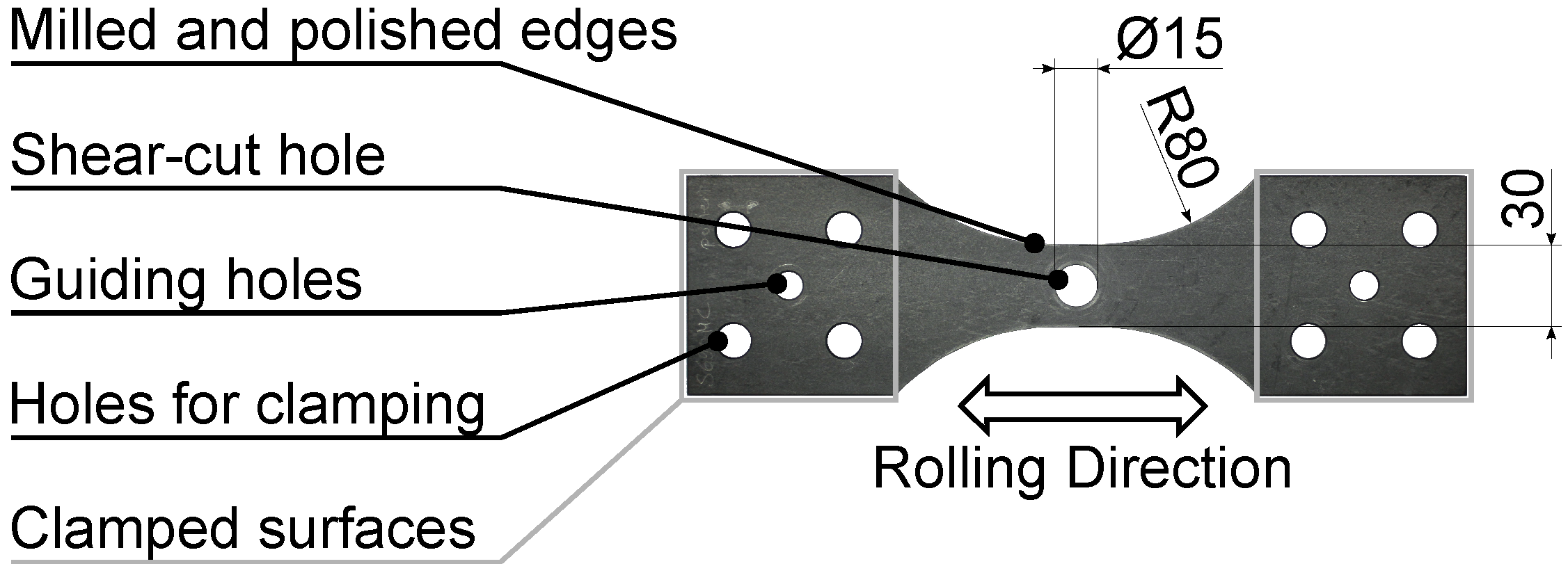
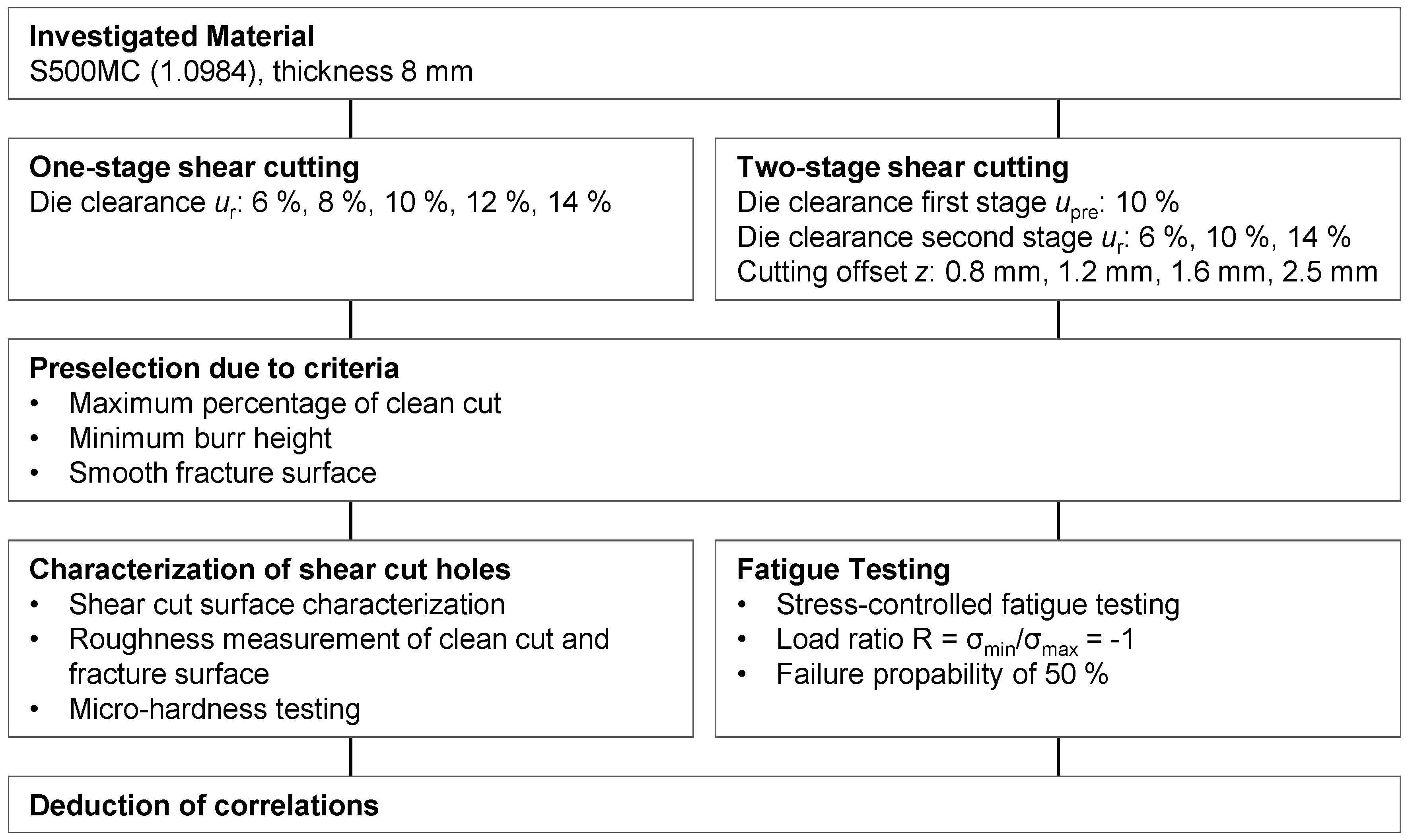

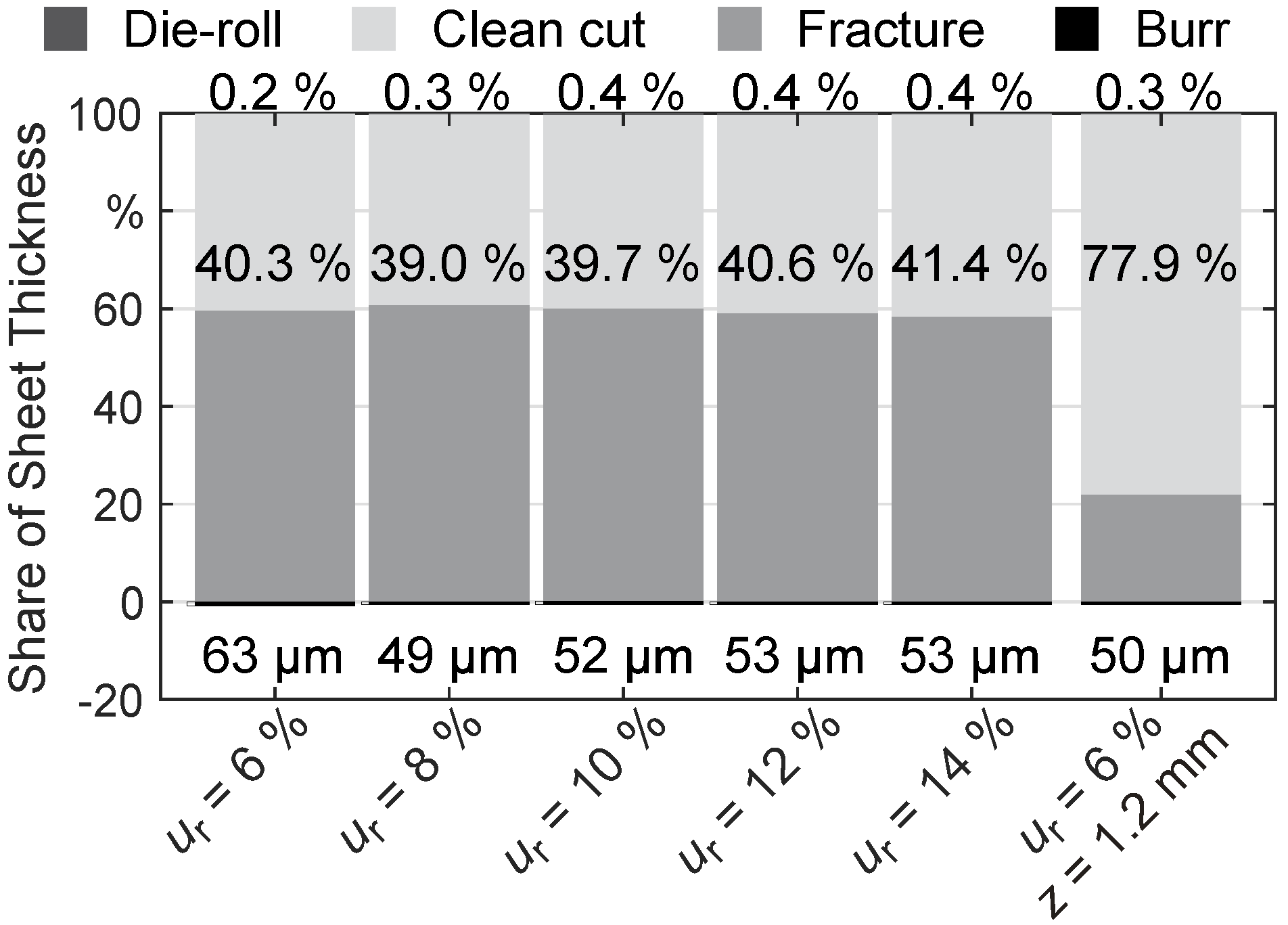
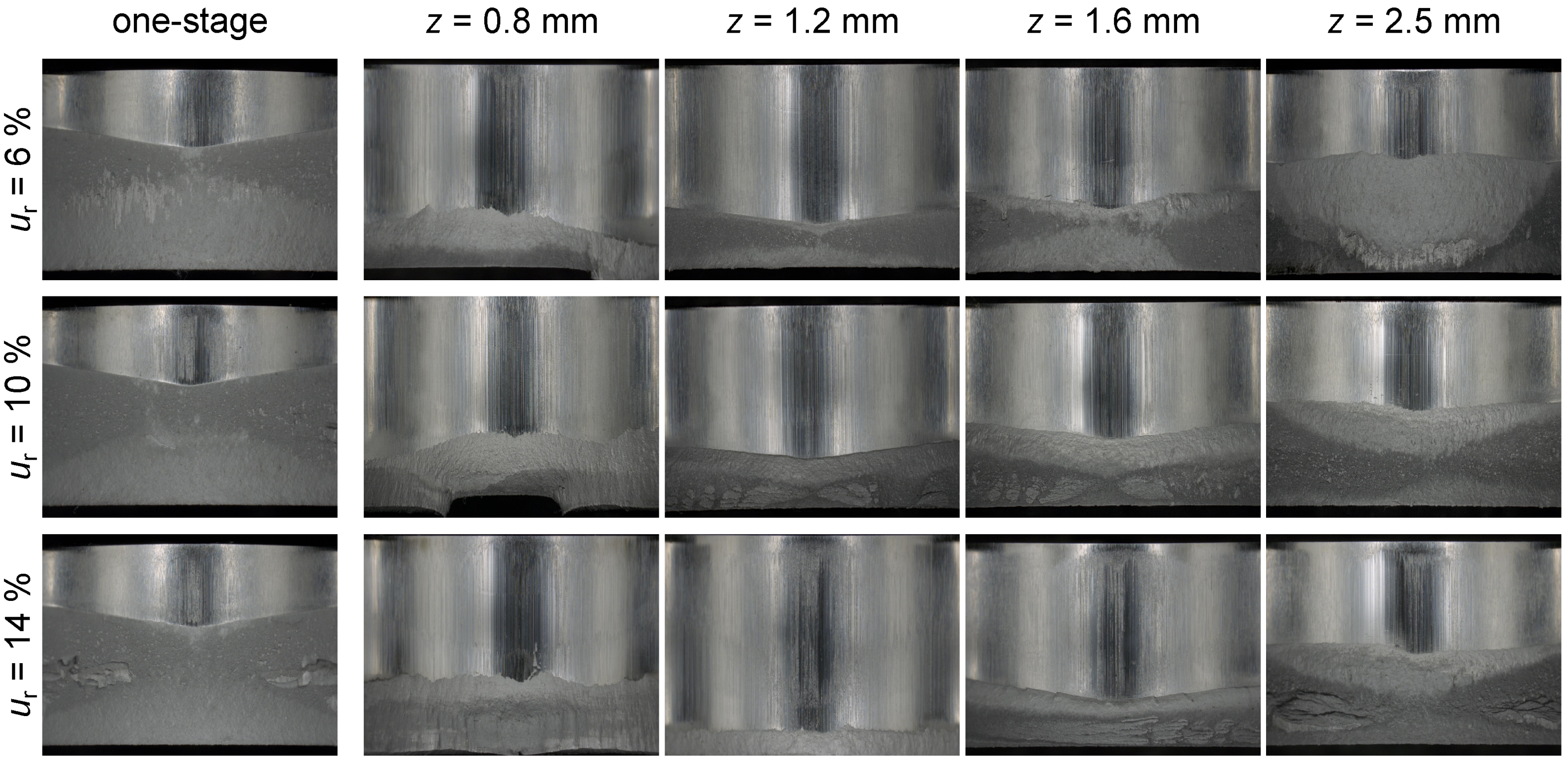

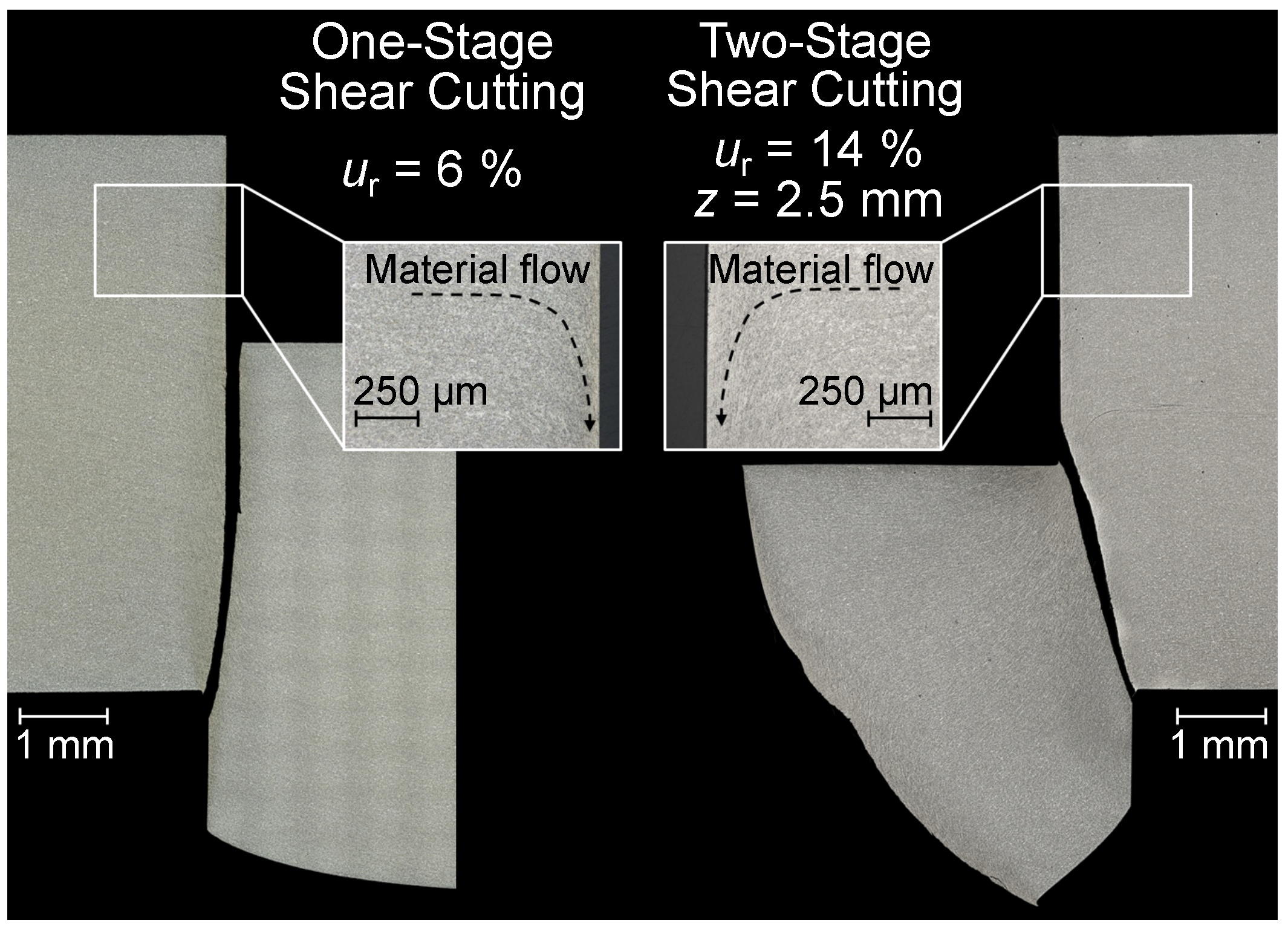

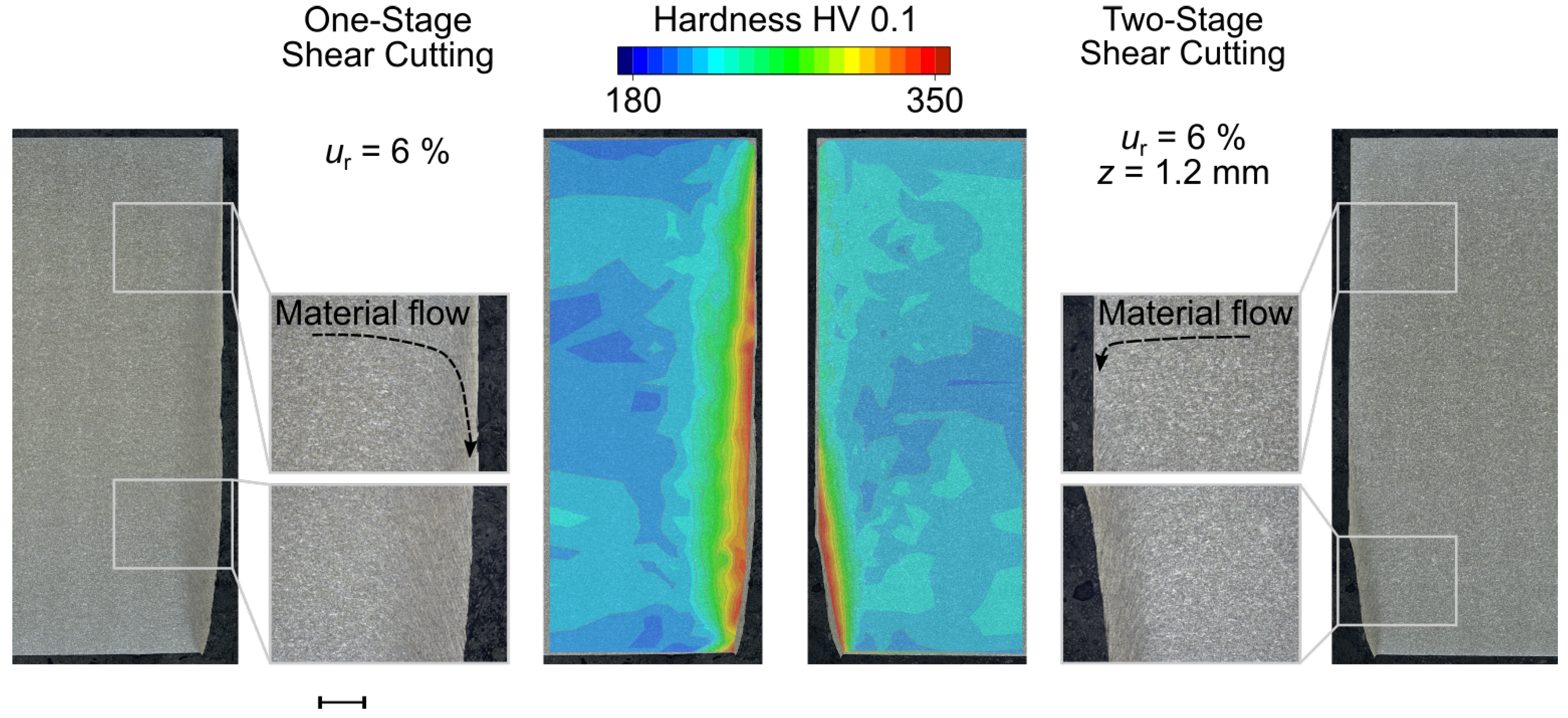
| 0 to the Rolling Direction | 562 ± 8.5 MPa | 642 ± 8.7 MPa |
| 90 to the Rolling Direction | 617 ± 0.9 MPa | 660 ± 0.9 MPa |
| C | Si | Mn | P | S | Al | Nb | V | Ti |
|---|---|---|---|---|---|---|---|---|
| 0.052 | 0.019 | 1.327 | 0.009 | <0.002 | 0.036 | 0.023 | 0.009 | 0.046 |
| Variant | Die Roll | Clean Cut | Fracture | Burr |
|---|---|---|---|---|
| One-Stage = 6% | 16 ± 4 | 3.19 ± 0.14 | 4.72 ± 0.14 | 63 ± 8 |
| One-Stage = 8% | 21 ± 4 | 3.11 ± 0.05 | 4.83 ± 0.04 | 49 ± 12 |
| One-Stage = 10% | 32 ± 6 | 3.15 ± 0.07 | 4.76 ± 0.08 | 52 ± 9 |
| One-Stage = 12% | 31 ± 9 | 3.23 ± 0.09 | 4.69 ± 0.11 | 53 ± 6 |
| One-Stage = 14% | 28 ± 8 | 3.31 ± 0.05 | 4.65 ± 0.05 | 53 ± 7 |
| Two-Stage = 6%, z = 1.2 | 20 ± 4 | 6.22 ± 0.03 | 1.74 ± 0.04 | 50 ± 10 |
| Variant | ||
|---|---|---|
| One-Stage = 6% | 0.26 ± 0.09 | 2.45 ± 0.55 |
| One-Stage = 10% | 0.48 ± 0.05 | 3.57 ± 0.32 |
| Two-Stage = 6%, z = 1.2 | 0.66 ± 0.09 | 3.71 ± 1.09 |
| Variant | ||
|---|---|---|
| One-Stage = 6% | 2.63 ± 0.27 | 15.6 ± 1.69 |
| One-Stage = 10% | 2.48 ± 0.24 | 14.6 ± 0.98 |
| Two-Stage = 6%, z = 1.2 | 3.22 ± 0.80 | 18.6 ± 3.74 |
© 2020 by the authors. Licensee MDPI, Basel, Switzerland. This article is an open access article distributed under the terms and conditions of the Creative Commons Attribution (CC BY) license (http://creativecommons.org/licenses/by/4.0/).
Share and Cite
Stahl, J.; Pätzold, I.; Golle, R.; Sunderkötter, C.; Sieurin, H.; Volk, W. Effect of One- and Two-Stage Shear Cutting on the Fatigue Strength of Truck Frame Parts. J. Manuf. Mater. Process. 2020, 4, 52. https://doi.org/10.3390/jmmp4020052
Stahl J, Pätzold I, Golle R, Sunderkötter C, Sieurin H, Volk W. Effect of One- and Two-Stage Shear Cutting on the Fatigue Strength of Truck Frame Parts. Journal of Manufacturing and Materials Processing. 2020; 4(2):52. https://doi.org/10.3390/jmmp4020052
Chicago/Turabian StyleStahl, Jens, Isabella Pätzold, Roland Golle, Christina Sunderkötter, Henrik Sieurin, and Wolfram Volk. 2020. "Effect of One- and Two-Stage Shear Cutting on the Fatigue Strength of Truck Frame Parts" Journal of Manufacturing and Materials Processing 4, no. 2: 52. https://doi.org/10.3390/jmmp4020052
APA StyleStahl, J., Pätzold, I., Golle, R., Sunderkötter, C., Sieurin, H., & Volk, W. (2020). Effect of One- and Two-Stage Shear Cutting on the Fatigue Strength of Truck Frame Parts. Journal of Manufacturing and Materials Processing, 4(2), 52. https://doi.org/10.3390/jmmp4020052





